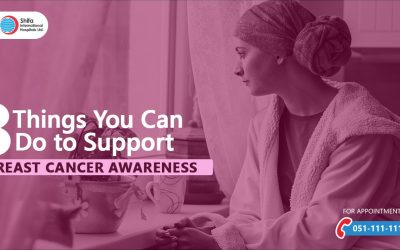
Shifa Breast Clinic
Healthcare statistics show an alarming increase in the incidence & prevalence of Breast Cancer in Pakistan. Breast cancer awareness is a sensitive subject in Pakistan, as our social behaviour generally restricts women to discuss it openly with family members and medical professionals. As a consequence, women might generally feel hesitant to discuss any initial abnormality, which can otherwise be cured.
- Breast Cancer is the most common type of Cancer in Women worldwide
Source: Breast Cancer Research Foundation (U.S) - Pakistan alone has the highest rate of Breast Cancer than any other Asian country. 90,000 new cases are diagnosed every year out of which 40,000 dies. 1 out of every 9 women is likely to suffer from this disease at any point of time in their lives
Source: Journal of Pakistan Medical Association
Early detection of breast cancer is vital as it is believed to have an increased number of available treatment options, increased survival, and improved quality of life.
Shifa Breast Clinic:
At Shifa Breast Clinic, a multidisciplinary team of professionals provides personalized care to breast cancer patients by offering effective options for diagnosis and treatment including complex and rare conditions.
A breast cancer diagnosis can be overwhelming and to help patients get through each stage from screening to treatment, the clinic offers the services of a breast nurse educator and navigator.
Our breast clinic offers;
- Consultation with board-certified, internationally trained oncologists, surgeons, pathologists, radiologists, etc.
- Complete diagnosis & treatment facilities
- Clinical breast exams
- Mammography
- Breast ultrasound
- Biopsy
- Multidisciplinary tumour board
- Breast-conserving surgery
- Mastectomy including skin-sparing & breast reconstructions
Breast cancer is a malignant (cancerous) tumour that starts from cells of the breast. The disease occurs mostly in women, but men can also be a victim of breast cancer. When tumour cells reach the lymph nodes in the axilla, then the chance of its spread to other parts of the body increases. Yet we do not know exactly what causes breast cancer, but we do know that certain risk factors are linked to the disease. Having a single risk factor or even several does not mean that a person will get the disease. Some women who have one or more risk factors never get breast cancer, and most women, who do get breast cancer, do not have any risk factor. While all women are at risk for breast cancer, the risk factors explained later can increase a woman’s chances of having the disease.
Staging & Treatment:
To guide treatment, breast cancer is “staged.” The stage is based on:
- Size and where the tumour is
- Whether cancer cells are found in the lymph nodes
- Whether cancer cells are found in other parts of the body
Stage ranges from stage 0 (called carcinoma in situ) to stage IV (tumours that have spread to other parts of the body). The stage and type of breast cancer will help your provider plan your treatment.
Most of the time, these treatments are used:
Early/Moderate Stage (0-II):
- Surgery is a treatment option done to remove most cancer. The types of surgeries done on breast cancer patients are lumpectomy (also called breast-conserving surgery) or mastectomy, and lymph node tissue sample.
- MANY patients MIGHT NEED chemo after surgery (called adjuvant therapy) to keep cancer from coming back (called recurrence).
- Radiation therapy is often used after breast-conserving surgery to cut down the risk of cancer coming back.
- Hormonal therapy may be used if the growth has positive estrogen and/or progesterone receptors.
- Targeted therapy may be used if the growth has an HER-2 overexpression.
Advanced Breast Cancer (III or IV) or breast cancers that were stage 0-II at when they were first found and have come back in other parts of the body:
- Surgery may be used and can be a mastectomy, lumpectomy, lymph node removal, and reconstruction.
- Chemotherapy is often used in advanced cancer.
- Targeted therapies are meds that work against a certain target found on the cancer cells. They are used to treat cancers that are HER2+ as well as cancers that have other targets like mTor, CD4/CD6, and EGFR. You will be tested for certain targets to decide if these therapies are a choice for you.
- Hormone therapy is used to treat cancers that are estrogen and/or progesterone receptor-positive.
- Radiation therapy can be used in a number of ways for advanced breast cancer such as treatment after mastectomy, radiation to the lymph node area, and treating tumours that are causing problems in other parts of the body.
General Risk Factors:
Age: On average, women over 60 are more likely to be diagnosed with breast cancer. Only about 10 to 15 per cent of breast cancers occur in women younger than 45.
Gender: Breast cancer is 100 times more common in women than men.
Genetics:
Family History: Having a family history of breast cancer, particularly women with a mother, sister, or daughter who has or had breast cancer, may double the risk.
Inherited Factors: Some inherited genetic mutations may increase your breast cancer risks.
Body:
Obesity: After menopause, fat tissue may contribute to increases in estrogen levels, and high levels of estrogen may increase the risk of breast cancer.
Not Having Children: Women who have had no children, or who were pregnant later in life (over age 35) may have a greater chance of developing breast cancer.
High Breast Density: If your mammography shows that you have dense breast tissue, it makes breast cancer screening more difficult and it may increase the risk of breast cancer (Please ask for doctor’s advice to know more about dense breast tissues).
Certain Breast Changes: Certain benign (noncancerous) breast conditions may increase breast cancer risk.
Menstrual History: Women who start menstruation at an early age (before age 12) and/ or menopause at an older age (after age 55) have a slightly higher risk of breast cancer.
LifeStyle:
A Sedentary Lifestyle: Physical activity in the form of regular exercise for 4 to 7 hours a week may help to reduce breast cancer risk
Previous Treatments:
Birth Control Pills: Using oral contraceptives within the past 10 years may slightly increase the risk of developing breast cancer
Combined Post-Menopausal Hormone Therapy (PHT): Using combined hormone therapy after menopause increases the risk of developing breast cancer
Diethylstilbestrol Exposure (DES): Previous use of DES, a drug commonly given to pregnant women from 1940 to 1971 to prevent miscarriage, may slightly increase the risk of developing breast cancer
Radiation Exposure: Women who had radiation therapy to the chest area as treatment for another cancer have a higher risk for breast cancer
Helpline:
Contact: 0518464646, 0518464610, 03468551831
The initial stages of breast cancer may not have any warnings. As the mass grows in size, it can cause problems like:
- Lump or hardening in the breast or underarm
- Change in size or shape of the breast
- Fluid from the nipple or the nipple turning inward
- Redness or scaling of the skin or nipple
- Ridges or pitting of the breast (looks like an orange peel)
How to Detect Breast Cancer?
Mammography:
Yearly mammography screening is recommended as per medical guidelines for every woman (40 years and above). Mammography can detect breast cancer before the tumour can be felt via breast self-exam. A mammography scan is an X-ray to find any abnormality and changes in the breast. Shifa breast clinic houses the latest 3D Hologic mammography machine which ensures faster scan with low radiation and finds 40% more invasive cancer than 2D alone.
Breast Ultrasound:
As per recommendation by physician & generally performed for women under the age of 40. Sometimes it is prescribed in combination with Mammography.
MRI of Breast:
As per the physician’s advice, it can be used as a supplemental tool to Breast Screening with mammography or ultrasound
Clinical Breast Exam:
Between the ages of 20-39, women should have a clinical breast exam by a physician or a nurse once every three years. After the age of 40, women should have a breast exam every year. The clinical breast exam should be done before the mammography.
Biopsy:
A breast biopsy is a test that removes tissues or sometimes fluid from the suspicious area. The removed cells are examined under a microscope and further tested to check for the presence of breast cancer. A biopsy is the only diagnostic procedure that can definitely determine if the suspicious area is cancerous.
- Fine needle aspiration
- Core-needle biopsy
- Surgical biopsy
Breast Self-Exam at Home:
All women aged 20 or over should do breast self-examination every month at home
An important way to keep up with your breast health is to be aware of how your breasts normally look and feel, and know what changes to look for. Finding breast cancer as early as possible gives you a better chance of successful treatment. But knowing what to look for is not a substitute for screening mammography and other tests, which can help find breast cancer in its early stages, even before any symptoms appear.
Below are some common breast symptoms and what they might mean.
- A lump in your breast
- Swelling in or around your breast, collarbone, or armpit
- Skin thickening or redness
- Breast warmth & itching
- Nipple changes
- Nipple discharge
- Pain
Resources: Flyers
Articles for Breast Cancer
8 things you can do to support Breast Cancer Awareness
8 Things you can do to support Breast Cancer Awareness Every October is recognized as Breast Cancer Awareness Month, providing a...
How Breast Cancer Treatments Can Affect the Immune System?
It is a harsh reality that breast cancer treatments are physically difficult. Procedures such as chemotherapy, radiation, and...
Latest Advancements in Breast Cancer Treatment Methods in Pakistan
According to the World Health Organization, to this day breast Cancer remains one of the two most common types of cancer in the...



